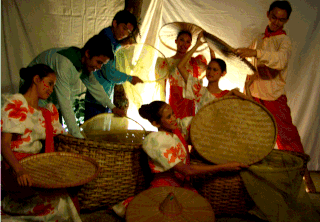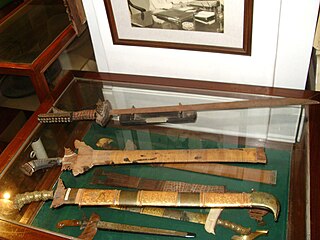This article is being considered for deletion in accordance with Wikipedia's deletion policy. Please share your thoughts on the matter at this article's entry on the Articles for deletion page. |
This article has multiple issues. Please help improve it or discuss these issues on the talk page . (Learn how and when to remove these template messages) (Learn how and when to remove this template message)
|
| Battles of Manila |
|---|
| See also |
|
| Around Manila |
|
The Battle of Manila (Filipino: Labanan sa Maynila) (1365) is an unspecified[ according to whom? ] and disputed[ by whom? ] battle occurring somewhere in the vicinity of Manila between the forces of the kingdoms in Luzon and the Empire of Majapahit.

Filipino is the national language of the Philippines. Filipino is also designated, along with English, as an official language of the country. It is a standardized variety of the Tagalog language, an Austronesian regional language that is widely spoken in the Philippines. As of 2007, Tagalog is the first language of 28 million people, or about one-third of the Philippine population, while 45 million speak Tagalog as their second language. Tagalog is among the 185 languages of the Philippines identified in the Ethnologue. Officially, Filipino is defined by the Commission on the Filipino Language as "the native dialect, spoken and written, in Metro Manila, the National Capital Region, and in other urban centers of the archipelago."
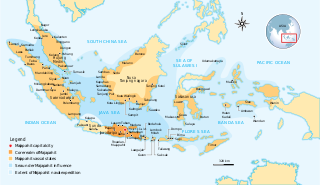
The Majapahit Empire was a thalassocracy in Southeast Asia, based on the island of Java, that existed from 1293 to circa 1500. Majapahit reached its peak of glory during the era of Hayam Wuruk, whose reign from 1350 to 1389 was marked by conquest which extended through Southeast Asia. His achievement is also credited to his prime minister, Gajah Mada. According to the Nagarakretagama (Desawarñana) written in 1365, Majapahit was an empire of 98 tributaries, stretching from Sumatra to New Guinea; consisting of present-day Indonesia, Singapore, Malaysia, Brunei, southern Thailand, East Timor, Sulu Archipelago and other parts of the Philippines, although the true nature of Majapahit sphere of influence is still the subject of studies among historians.
Even though the exact dates and details of this battle remain in dispute, there are claims[ by whom? ] of the conquest of the area around Saludong (Majapahit term for Luzon and Manila) according to the text of the Nagarakretagama [1] which claims that Saludong (Luzon) and Solot (Sulu) were parts of Majapahit. This claim may be mythical[ according to whom? ] because a couple of years later, warriors from Sulu had successfully attacked Borney (Brunei) which was a Majapahit vassal (Although at this point, the seeds of Islam had already planted and their eventual rebellion to Majapahit was there but only gestating but at the point they were still a loyal Majapahit province but before hand the secretly Muslim Bruneians living under Hindu Majapahit rule sent Rajah Ahmad a person with a Muslim name but a Hindu honorific to attack and incorporate Selurong), and nevertheless the Sulus subsequently repulsed a Majapahit invasion force after they were once invaded by Majapahit, and because outside of the Nagarakretagama, there is no evidence[ according to whom? ] among pre-Hispanic Philippine documents that Saludong or Sulu was ever enslaved by the Majapahit empire. In fact, this claim was only mentioned in passing in a lone eulogy poem to Maharajah Hayam Wuruk and was not really a part of statecraft. [2] Furthermore, the earlier Laguna Copperplate Inscription mentioned that Dongdu (Kingdom of Tondo) had diplomatic relations with the Kingdom of Medang, not with Majapahit.
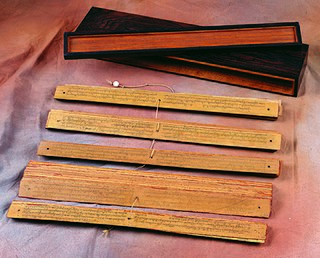
The Nagarakretagama or Nagarakrtagama, also known as Desawarñana or Deshavarñana, is an Old Javanese eulogy to Hayam Wuruk, a Javanese king of the Majapahit Empire. It was written on lontar as a kakawin by Mpu Prapanca in 1365. The Nagarakretagama contains detailed descriptions of the Majapahit Empire during its greatest extent. The poem affirms the importance of Hindu–Buddhism in the Majapahit empire by describing temples and palaces and several ceremonial observances.

Luzon is the largest and most populous island in the Philippines. It is ranked 15th largest in the world by land area. Located in the northern region of the archipelago, it is the economic and political center of the nation, being home to the country's capital city, Manila, as well as Quezon City, the country's most populous city. With a population of 53 million as of 2015, it is the fourth most populous island in the world, containing 52.5% of the country's total population.
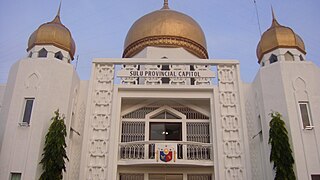
Sulu is a province of the Philippines in the Sulu Archipelago and part of the Bangsamoro Autonomous Region in Muslim Mindanao (BARMM).
Nevertheless, there may have been a battle for Manila that occurred during that time but it was likely a victory for Luzon's kingdoms considering that the Kingdom of Tondo had maintained its independence and was not enslaved under another ruler. Alternatively, Luzon may have been successfully invaded but was able to regain its independence later. [3] [4] Scholars[ who? ] are still in dispute over this.
There is information however in Chinese and Bruneian records[ citation needed ] that when Sulu rebelled against Majapahit when some Datus were freed from the grip of Empire and they sacked Brunei which was then a part of Hayam Wuruk's empire as stated in the Nagarakretagama, the state "Sulu" (Solot) split into three kingdoms[ citation needed ] then and afterwards a Datu from the successful sack of Brunei went to towadS the undercurrent towards Luzon and established a Barangay in Cavite near the polity of Selurong (Present day Manila) and thus allying Selurong with Sulu in an alliance against a powerful empire.[ attribution needed ] Thus inspiring them to fight against said empire. [5] [ irrelevant citation ]

Cavite is a province in the Philippines located on the southern shores of Manila Bay in the Calabarzon region on Luzon island. Situated 21 kilometres (13 mi) southwest of Metro Manila, it is one of the most industrialized and fastest growing provinces in the Philippines. Its population of 3,678,301 (2015) makes it one of the most populated provinces in the country.
Nevertheless, Sulu and Selurong are still enriched and also exploited by the brief Majapahit occupation of their kingdoms.[ citation needed ] The martial prowess of the Filipino kingdoms were later proven when during the age of exploration, Filipinos (Some Lucoes) and others descended from the Bisaya or Visayans, were empoyed all across Southeast Asia and even elsewhere in key naval and military positions, this was due to the skills and expertise which was facilitated by incessant inter kingdom conflicts, trade and exchanges across the states in the islands of the archipelago which are also prone to natural disasters; frequent deaths and slavery due to war and natural disasters and frequent intermarriage and family branch outs tested with said wars and disasters pruned and refined the Filipino people then as a result that eventually Lucoes (Filipino) Generals and officers from humble and poor beginnings earned command of the Malaccan, Bruneian and Timorese navies were; Temegung Regimo de Raja was Chief General of Malacca under the Portuguese [Emphasis on the fact that, Malacca is the most contested maritime chokepoint in the world and you have to the best ever to earn a position there and a Filipino earning the supreme position there is quite telling], Admiral Rajah Sulayman was head of the fleet of Brunei, Sapetu Diraja was commander of the Aceh (Sumatra Garrison) and Enrique a Kampapangan was a commander in Timor. A simple hypotheis; all are proof that: the Datus of, and the Rajahs, and Sultans, Wangs, Haris and Lakans and etc. of the Philippines were great military figures in the region, justifying the successful rebellion of these states from Imperial occupation. [6]
Regimo de Raja was a Filipino (Lucoes) general, governor and spice magnate who found work in Portuguese Malacca. He was highly influential and the Portuguese appointed him as Temenggung or a governor and chief general responsible for overseeing of the maritime trade, protecting the monarch and policing the state. As Temenggung, he was also the head of a fleet which traded and protected commerce between the Indian Ocean, the Strait of Malacca, the South China Sea, and the medieval maritime principalities of the Philippines. His father and wife carried on his maritime trading business after his death.










